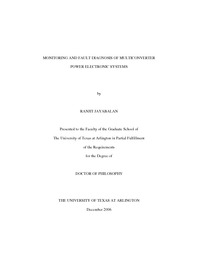
ATTENTION: The works hosted here are being migrated to a new repository that will consolidate resources, improve discoverability, and better show UTA's research impact on the global community. We will update authors as the migration progresses. Please see MavMatrix for more information.
Show simple item record
| dc.contributor.author | Jayabalan, Ranjit | en_US |
| dc.date.accessioned | 2007-08-23T01:56:52Z | |
| dc.date.available | 2007-08-23T01:56:52Z | |
| dc.date.issued | 2007-08-23T01:56:52Z | |
| dc.date.submitted | September 2006 | en_US |
| dc.identifier.other | DISS-1503 | en_US |
| dc.identifier.uri | http://hdl.handle.net/10106/495 | |
| dc.description.abstract | Over the recent years the electric loads in automobiles have increased considerably due to advancements in high-power semiconductor based converters. However, with increasing electrical and electrically driven loads, there have been increasing concerns on system reliability. Faults occurring in such application specific solid state converters can lead to fatal consequences as compared to their mechanical counter parts. Thus, it is vital to identify faults in such systems to develop necessary safety techniques and methodologies.
Detailed analysis of faults processes has indicated the need to act quickly following a device failure to prevent propagation of faults that may lead to catastrophic failure of the converter affecting the load, source and connected system. To minimize the effect of fault, it is essential to accurately identify the failed devices and their mode of failure.
The technique presented in the dissertation involves the use of statistical moments of higher orders to detect and identify a fault. This utilizes the existing current and voltage sensors (port parameters) of the multiconverter system without the need for any additional sensors. The technique not only detects system malfunction, but provides information on the device under fault and the nature of the fault. An accurate knowledge of the same will allow appropriate actions to be taken to avoid propagation of fault that may lead to catastrophic failure.
Analysis indicate third-order statistical moments are effective as they dynamically evaluate and monitor system deviations (voltages, currents) from normal operations and direction of the deviations that enable to detect and diagnose fault fast enough to prevent escalation. Thus idea behind the techniques is to detect, identify and act quickly on a single device failure to prevent escalation of the fault that would otherwise occur if the controller continued to operate without the knowledge of the fault situation. In addition, failure mode information derived from the system is essential for isolation of fault/reconfiguration of safety critical systems such as in Hybrid Electric Vehicle Power System to ensure sustainable operation and safety. | en_US |
| dc.description.sponsorship | Fahimi, Babak | en_US |
| dc.language.iso | EN | en_US |
| dc.publisher | Electrical Engineering | en_US |
| dc.title | Monitoring And Fault Diagnosis Of Multiconverter Power Electronic Systems | en_US |
| dc.type | Ph.D. | en_US |
| dc.contributor.committeeChair | Fahimi, Babak | en_US |
| dc.degree.department | Electrical Engineering | en_US |
| dc.degree.discipline | Electrical Engineering | en_US |
| dc.degree.grantor | University of Texas at Arlington | en_US |
| dc.degree.level | doctoral | en_US |
| dc.degree.name | Ph.D. | en_US |
| dc.identifier.externalLink | https://www.uta.edu/ra/real/editprofile.php?onlyview=1&pid=237 | |
| dc.identifier.externalLinkDescription | Link to Research Profiles | |
Files in this item
- Name:
- umi-uta-1503.pdf
- Size:
- 1.165Mb
- Format:
- PDF
This item appears in the following Collection(s)
Show simple item record


